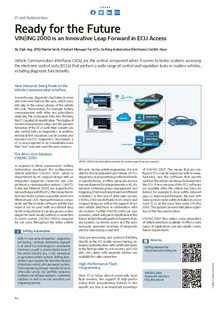MVCI Server
Accessing the Programming Interface of the ISO MVCI Server with Your Own Applications.
The use of Softing SDE.mvci for the development of proprietary applications enables users to gain full access to diagnostic functions in their own applications based on the ISO 22900-3/ASAM MCD-3D standardized API.
Users
- Developers of diagnostic and flash programming tools
- Creators of test sequences in engineering, the test environment and manufacturing
- Developers of repair shop testers and test sequences for the repair shop
Functions
- Offline and online access to diagnostic information – ODX data as diagnostic specifications
- Parameterization of diagnostic services
- Execution and symbolic evaluation of diagnostic services – working with physical variables
- Parameterization of the diagnostic protocol
- Hardware and system parameterization

Overview
Verified by the ASAM Test Suite
Softing DTS.cos is part of Softing’s Diagnostic Tool Set product family and makes it possible for user applications to access the programming interface of the ISO MVCI Server. Verified by extensive tests in accordance with the ASAM test suite, DTS COS is largely compatible with all relevant standards. Extensive trace functions enable developers and engineers to quickly detect errors in their own applications or in the communication with the ECUs.
Top Performance
In addition to the advantage of being able to use ODX and various bus protocols via VCIs made by various manufacturers, several ECUs can be accessed simultaneously or an entire vehicle can be accessed via different bus systems. If required, communication can also take place via several VCIs in parallel.
Faster Creation of Individual Applications
The API Developer Kit for the ISO MVCI Server contains a special test application alongside the comprehensive documentation and the programming examples. This makes it possible for engineers to establish communication to the vehicle or individual ECUs immediately, i.e. without their own application development. Using a special configuration API, the runtime system can be configured entirely by an external application in terms of VCIs, projects etc.
Do you have questions about our solutions or need support?
Please contact us – we are pleased about your interest!
Possible Applications
Access to Softing SDE.mvci is enabled with a two-part API: the standardized MVCI server API compliant with ISO 22900-3 (also D-Server API or ASAM MCD-3D API) and, in addition, the Softing Extension, which provides numerous helpful functions for managing data.
Among the API, the MVCI server has a few central components:
Offline Database Handler
This makes it possible to access ODX data without simultaneously requiring access to an ECU. While ODX data is organized hierarchically and without redundancy, here the hierarchies are dissolved and redundancies are created deliberately. As a result, the application receives a list of all protocols and ECUs as well as their variants. In turn, a complete set of diagnostic services can be accessed under each list item.
Online Database Handler
The information in the Online Database Handler is the same as in the offline case, which carries all the status information from the communication. This means that once a variant has been identified, only the recognized variant is available, the security status is known and all changes to service parameters are saved as the current setting.
Communication Channel Handler
The communication channel maintains the connection to a real ECU or a functional group of ECUs that are diagnosed together. The requests currently waiting to be sent are buffered until they are processed. The results interpreted using the ODX data are also buffered by the application until they are read out. In principle, any number of communication channels can be kept open in parallel.
D-PDU API Handler
The D-PDU API Handler manages active D-PDU APIs for accessing different VCIs (Vehicle Communication Interfaces). With a D-PDU API, several VCIs can also be operated in parallel, whereby the respective physical buses (e.g. CAN or Ethernet) are kept here with their parameterization and their communication status. Several D-PDU APIs can be used in parallel for example to use VCIs from several suppliers simultaneously.
Configuration Handler
This is where system settings such as paths and filters are managed. Some of these can be set using the Softing Extension on the API.











